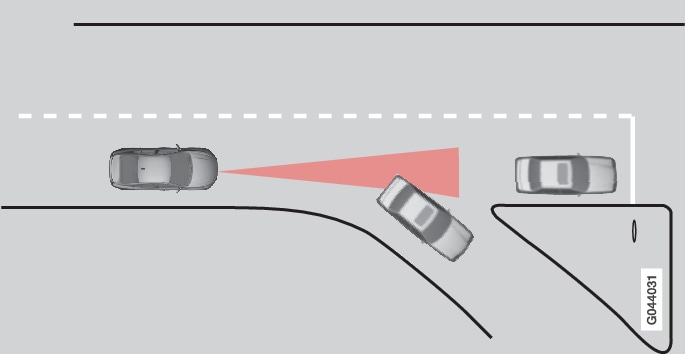In cars with automatic gearbox the adaptive cruise control is supplemented with the queue assistance function (also referred to as "Queue Assist").
- Extended speed range - also below 30 km/h (20 mph) and when stationary
- Change of target
- Automatic braking ceases when stationary
- Automatic activation parking brake.
Note that the lowest programmable speed for the adaptive cruise control is 30 km/h (20 mph) - even though it is capable of following another vehicle down to 0 km/h, a speed lower than 30 km/h (20 mph) cannot be selected/stored.
Extended speed range
Note
With an automatic gearbox, the adaptive cruise control can follow another vehicle within the range 0-200 km/h (0-125 mph).
Note
- Press the steering wheel button
 .
.
or
- Depress the accelerator pedal.
| > | The adaptive cruise control will then resume following the vehicle in front. |
Note
The Queue Assist function can hold the car stationary for a maximum of 4 minutes - then the parking brake is applied and the adaptive cruise control is disengaged.
- The parking brake must be released before the adaptive cruise control can be reactivated.
Change of target

When the adaptive cruise control is following another vehicle at speeds below 30 km/h (20 mph) and the target is changed from a moving vehicle to a stationary vehicle, the adaptive cruise control will brake for the stationary vehicle.
Warning
When the adaptive cruise control is following a vehicle in front at speeds in excess of 30 km/h (20 mph) and the target is changed from a vehicle in front to a stationary vehicle, the adaptive cruise control will ignore the stationary vehicle and instead select the stored speed.
- The driver must intervene him/herself and brake.
Automatic standby mode with change of target
- when the speed is below 5 km/h (5 mph) and the adaptive cruise control is uncertain whether the target object is a stationary vehicle or some other object, e.g. a speed bump.
- when the speed is below 5 km/h (5 mph) and the vehicle in front turns off so the adaptive cruise control no longer has a vehicle to follow.
Termination of automatic braking at a standstill
In certain situations, queue assistance stops automatic braking at a standstill. This means that the brakes are released and the car may start to roll - the driver must therefore intervene and brake the car himself/herself in order to maintain its position.
- the driver puts his/her foot on the brake pedal
- the parking brake is applied
- the gear selector is moved to P, N or R position
- the driver sets the adaptive cruise control in standby mode.
Automatic activation parking brake
In certain situations queue assistance applies the parking brake in order to keep the car remaining stationary.
- the driver opens the door or takes off his/her seatbelt
- ESC is changed from Normal to Sport mode
- Queue assistance has held the car stationary for more than 4 minutes
- the engine is switched off
- the brakes have overheated.